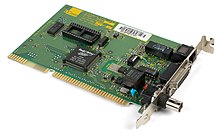Transceiver

A transceiver [trænssiːvə] ( German "transceiver" ) of English trans mitter , transmitter 'and re ceiver , receiver ', is a combination of both. The suitcase word originated in the 1930s . Transceivers are not only used in radio technology , but also in wired signal transmission, but not in broadcasting .
Generally accepted abbreviations are Rx for receiver , Tx for transmitter and Trx ( Xcvr ) for the transceiver .
use
Network adapter
In the case of computer technology network adapters , a transceiver is usually the component that is responsible for sending and receiving the signals via the transmission medium (more precisely: feeding and decoupling the signals into / from the medium). Depending on which transmission medium is used, it is electrical impulses , light or other electromagnetic waves .
The unit is also called the Medium Attachment Unit ( MAU ). On the network medium (cable) side, it forms the interface for connecting network stations. MAU and Attachment Unit Interface (AUI) are mostly housed on network cards today .
In the beginning of the Ethernet - network technology spread 10BASE5 -Koaxialkabel ( "Yellow Cable", "ThickNet", "RG8") was the transceiver is a separate device that has been clamped at the access point to the cable, wherein the contact with inner and outer conductor was produced. The network adapter of a computer was then connected via an AUI connection cable, which could be up to 50 m long due to the signal electronics contained in the transceiver. This allowed a certain flexibility in the choice of the installation location, despite the "ThickNet" cable, which is relatively rigid because of its thickness and therefore difficult to lay. The later used, thinner and much cheaper 10BASE2 cable ("Thinnet"), on the other hand, was led directly to the connections of the computer; With this technology, the transceiver was now integrated on the network adapter.
In the later “Combo” network adapters, AUI connectors were still available in addition to the (somewhat newer) 10BASE2 or 10BASE-T connection. Small, compact signal converter units for the connection of alternative transmission media such as fiber optic cables, etc., which are also referred to as transceivers, can also be attached there.
Modern network devices almost always have integrated transceivers for twisted pair Ethernet and sometimes offer (additional) slots for modular transceivers, which are used in particular for the different types of communication via fiber optic cables. Common forms are in particular Small Form-factor Pluggable (SFP and SFP +), QSFP28 or C Form-factor Pluggable (CFP), older Gigabit Interface Converter (GBIC), XFP and XENPAK .
Computer networks
A transceiver can also be a computer system that transfers data from one system to another. A connection computer between a merchandise management system and a PDA system is also referred to as a transceiver. Here it ensures the processing and forwarding of the information (in both directions).
RFID
In RFID technology, transceivers are used in the form of so-called "readers". These devices first send a signal to which the transponder (e.g. RFID tag) sends a response, which is then received by the transceiver and forwarded to a (computer) system for further processing.
literature
- Scott R. Bullock: Transceiver and System Design for Digital Communications. 2nd edition, Noble Publishing Corporation, Atlanta 2000, ISBN 1-884932-06-1 .
- Wolfgang Eberle: Wireless Transceiver Systems Design. Springer Science + Business Media LLC, Berlin 2008, ISBN 978-0-387-74515-2 .
- Woogeun Rhee: Wireless Transceiver Circuits. System Perspectives and Design Aspects, Taylor & Francis Group, Boca Raton 2015, ISBN 978-1-4822-3436-7 .
supporting documents
- ↑ www.computerweekly.com , accessed July 2, 2019.
- ↑ transceiver . In: Duden . Retrieved May 1, 2014.
- ↑ transceiver . In: Oxford English Dictionary . Retrieved May 1, 2014.


